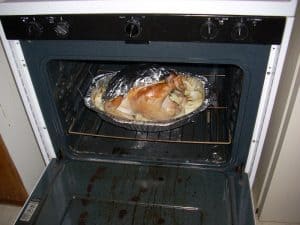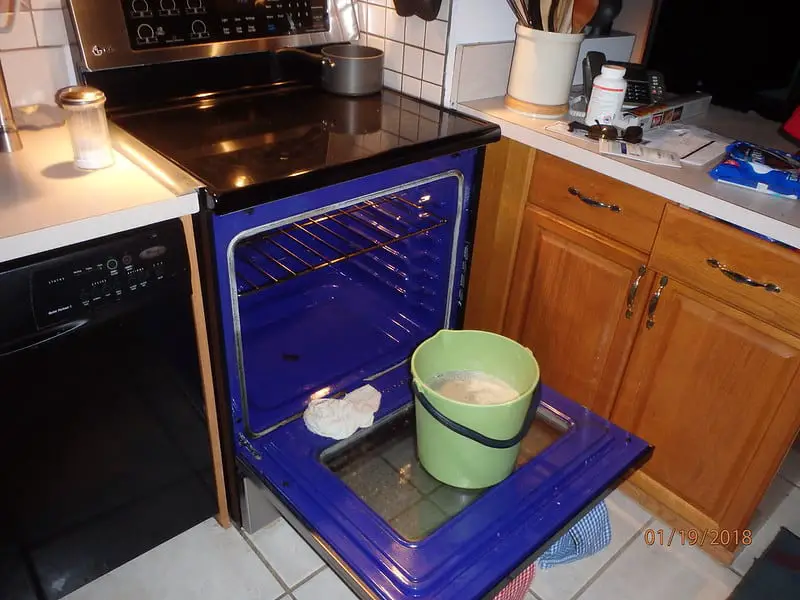There are two kinds of ovens out there:
- One that cleans itself – you just need to adjust it into the self-cleaning mode and it will heat itself clean.
- Then there’s the second type that must be physically cleaned just like any other kitchen appliance.
Either type will need to be cleaned after a few weeks of regular use.
Sometimes all you need is a moist piece of cloth, but other times a special kind of cleaning chemicals is necessary.
Whichever method the manufacturer of your oven recommends, a clean oven means clean and delicious food, and the whole routine may add a few years to the oven’s lifespan.
So, How Long Should You Wait To Use The Oven After You’ve Cleaned it?

While there’s no one answer to this question, we have a few recommendations that should be kept in mind. Also, the waiting period can depend on an array of factors, including whether you did it yourself (DIY) or left the oven to self-clean. Let’s dig deeper:
How long should you wait after DIY CLEANING?
DIY (Do It Yourself, if you didn’t know) cleaning is the only natural way of getting rid of the grime and greases on your oven.
The best thing about DIY cleaning is that you get to use your own cleaning paste (which you can easily make with your own ingredients).
The most often used paste is a mixture of baking soda and white vinegar.
If you choose the DIY washing paste, you can cook right after you have washed your oven with it.
That’s because both vinegar and baking soda are eco-friendly and healthy for human consumption.
So, if you cook with the oven while the particles or odor of these ingredients are still inside the chamber, there will be no threat to your health or the quality of your food.
Yes, that is the beauty of utilizing natural products for cleaning purposes, even though it may take a bit longer for your oven to get the sparkle.
How long if you use a COMMERCIAL CLEANING AGENT?

You may be wondering how long you should wait if you dump the natural cleaning products in favor of commercial products. There is no exact period, but it should take longer than the DIY method.
Commercial oven cleaners can be harsh to most surfaces.
Please imagine what it takes to remove those generational scorch marks, stubborn grease from your Thanksgiving turkey, and every other kind of froth and fat that has ever found its way on the surface of your oven!
That’s why manufacturers tend to combine some of the harshest chemicals they could lay their hands on to produce the most potent oven cleaner on the market.
A typical commercial oven cleaner is made up of several chemicals that are highly effective, but also dangerous when ingested.
Such chemicals as Amphoteric Surfactants and Sodium Hydroxide can inflict serious damages to your eyes, skin, eyes, and even lungs when inhaled – now imagine what they can do to your digestive system!
So, after cleaning your oven with a commercial oven cleaner,
DO NOT put your food inside immediately.
Firstly, give the unit a good wipe with a clean and damp rag.
Thereafter, proceed to heat your oven to the maximum temperature possible for 15 – 30 minutes.
Be CAUTIOUS: smoke will be emitted from the oven (often from the burning of the remnants of the cleaning product and moisture).
Avoid inhaling the smoke. The fumes normally last for several minutes if you used a lot of the cleaning product.
If there’s no considerable chemical residue left in the oven, less smoke will be produced. Still, you will need to wait for about half an hour to use the oven.
How long after the SELF CLEANING process?

Self-cleaning ovens don’t use commercial chemicals or homemade pastes to clean themselves.
The self-clean feature is a unique function that comes with the product.
It works by blasting the chamber of the oven with either steam or high heat to melt or release hardened food particles and scorch marks.
The oven locks automatically and the temperature shoots up to between 900 – 1,000 degrees Fahrenheit.
In such a searing hell, even the most stubborn grease or food particles will be incinerated to nothing.
Also bear in mind that the cycle lasts between 2 to 6 hours.
This is the most thorough way of cleaning your oven. That’s why the self-clean feature is one of the must-have features to consider when buying an oven.
Perhaps the biggest of all benefits that come with the self-clean feature is the fact that you don’t need to wait to use the oven after the cleaning process.
You are free to put your pizza in there right away, just make sure the oven is cool and all ashes have been removed. It normally takes about 30 – 90 minutes for the oven with a self-clean function to cool down.
Note that the locking mechanism will be still activated during this whole time, so you cannot open the door.
Once the cooling is complete, you can once open the door to the chamber, scrub off the ash, and proceed to cook your food.
White harmless ash is all that’ll remain behind all the grime and nasty food spills.
This process is often referred to as pyrolysis.
Depending on the degree of dirt in your oven, you might have a lot of ash or the opposite.
Regardless of this, you can easily remove it with a damp rag dipped in white vinegar and water.
The Do’s and Don’ts of Oven Cleaning

DON’T assume all the oven parts can be cleaned.
Start by reading the user manual that came with your oven.
Doing so will help you understand the workings of your oven as well as which areas really need to be washed.
Generally, stay away from the heating elements (often installed on the floor and roof of the oven).
These heating elements are often delicate and cleaning them could scratch the heads.
If you start cleaning right after cooking when the heads are still warm or hot enough to start another fire, sparks or flames may ensue.
Similarly, take care when cleaning the oven’s flexible gasket (often located inside the oven door) lest you degrade the oven seal. The job of the seal is to prevent heat from escaping out of the oven.
If your oven is the self-cleaning type, DON’T use commercial chemical-based cleansers.
Yes, don’t use commercial chemical-based cleaners in a self-cleaning oven.
Also, don’t use chemical-based paste you’ve made yourself at home.
However, if you want to clean it with your own DIY cleaner so bad, ensure that it is made up of mild chemicals that won’t ruin the surface of the oven or spoil your food if, by any chance, gets on it.
As aforementioned, read your oven’s user manual to identify all the washable parts as well as compatible commercial products.
Some chemical-based cleansers may be safe for certain conventional ovens.
Self-cleaning ovens, however, are designed to clean themselves without a cleaner, and partly because they are coated with a delicate enamel that may be corroded with chemicals.

Store-obtained oven cleansers made from non-toxic, biodegradable materials such as Carbona Biodegradable Oven Cleaner present an eco-friendly, safer, alternative to chemical-laden and often toxic cleansers.
DO start with a cool, empty oven.
To avoid the risk of burning your hands, turn off the oven and let it cool completely if you plan to wash it the DIY way.
Remove any oven racks, pots, and pans from the oven to get enough clearance for the walls, roof, and floor.
Likewise, remove all the loose food residues or large particles of debris from the surface of the chamber by gently scraping off using a spatula or scrub.
DO pre-soak each oven component to reduce the cleaning time.
You can save a lot of time by applying your mild DIY cleaner to each component of the oven in advance of the cleaning exercise.
Remember to let it soak the cleanser for some time.
Doing so helps loosen the tough grime and remove the need for some heavy-duty scrubbing during cleaning an oven.
Remember to wear gloves, follow the recommended pre-soak regimen suitable for your oven (read the manual).
Related: Is It OK To Use Your Oven Or Range As A Heater?
Generally:
Oven racks
- Lay the racks beside each other in a large kitchen sink or empty bathtub, then sprinkle every rack with a thick layer of spritz vinegar and baking soda.
- Wait for the baking soda to stop foaming, then fill the sink or tub with plenty of hot water to completely submerge the racks.
- Proceed to let them dwell in the sink overnight.
Oven walls, floor, roof:
- Using a gloved hand, spread your homemade cleaner overall exposed interior oven surfaces.
- Avoid the heating elements raised on the floor and roof.
- Let your baking soda paste stay in the chamber for 6 – 8 hours.
Oven window glass:
- Start by spreading any leftover homemade cleaner evenly on the window glass from inside the oven.
- Allow it to dwell for 15 minutes, then wipe it off with a damp rag.


